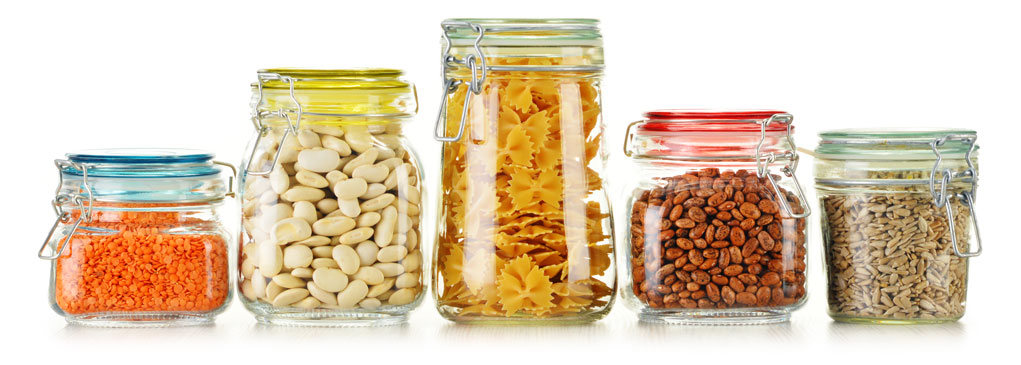COVID-19 is causing closures, quarantine, and “social distancing” protocols across the nation. For many, this means eating more meals at home, and possibly limited access to grocery stores. Most of us are making less trips to the grocery store, or relying on grocery delivery. Smart shopping is more important than ever to keep your kitchen stocked with healthy, shelf-stable foods.

Related: Tips and Recipes for Staying Healthy While Staying Home
While the pandemic isn't directly impacting our food supply, it is affecting our ability to shop for groceries and find what we need. Stay at home measures mean less trips to the grocery store, and more people stocking up on food means some foods may be harder to find on the shelves.
Here's out list of pantry staples to keep your kitchen stocked, and what to look for keep meals diabetes-friendly.
Frozen Foods
-
Stock up on your favorite frozen vegetables! Good choices are: broccoli, spinach, cauliflower, edamame, green beans, etc.
-
Frozen fruits—great for smoothies or adding to yogurt or oatmeal
-
If you’re having trouble finding frozen foods due to shortages, buy fresh and freeze it yourself (see below)
How to Freeze Fresh Foods
Vegetables:
- Dice onions, bell peppers, carrots, etc; portion in freezer-safe bags and pop them straight in the freezer.
- For vegetables like broccoli and spinach: cook in boiling water for 1-2 minutes, then drop in ice water. Drain thoroughly and freeze.
- To keep things from clumping together, lay chopped veggies out on a baking sheet and freeze for at least a couple of hours, then transfer to a freezer-safe bag.
Fresh herbs: chop and store in ice cube trays submerged in water or oil. Once they are frozen solid, you can transfer them to a freezer-safe bag.
Fresh fruit that freezes well: berries, pineapple, bananas, mango, peaches, plums, apricots.
Meat, fish, poultry: wrap in plastic wrap and aluminum foil to protect from freezer burn, or store in airtight, freezer bag (remove as much air as possible before sealing).
- Thaw before using: the safest method for thawing raw meat is in the refrigerator (it can take one or more days to completely thaw). If you need to thaw faster, you can thaw under cold, running water in the sink, or in the microwave. Do NOT thaw raw meat on the counter.
Dairy: milk, yogurt, cheese, and butter all freeze well. For milk and other liquids, leave space in the container—liquids expand when they freeze.
Fresh Produce
While shelf-stable foods like frozen and canned foods may be more scarce, the fresh produce section is typically well-stocked. Buy fresh produce with a longer shelf life, or buy things that you can prep and freeze for later. Stock up on flavorful staples like garlic, onions, scallions, fresh herbs, and lemons/limes; these are the base of many recipes, and add bursts of flavor to keep meals enjoyable.
-
Longest shelf life (store on counter or in pantry): onions, potatoes, sweet potatoes, garlic, butternut squash, acorn squash, spaghetti squash, and melons.
-
Medium shelf life (store in fridge): cabbage, bagged greens such as kale and collards, summer squash, brussels sprouts, cauliflower, broccoli, carrots, beets (remove greens if attached), apples, and citrus fruit.
Canned/Jarred Foods
-
Canned protein like tuna, salmon, chicken, sardines, anchovies—look for options packed in water instead of oil.
-
Canned vegetables—look for low sodium or no-salt-added if possible.
-
Canned tomatoes—buy some large cans of tomatoes (diced, crushed, or whole)—they’re a good base for any number of soups, stews, chilis, and sauces.
-
Canned fruit—look for fruit packed in water or 100% juice (not heavy syrup).
-
Applesauce—look for no sugar added.
-
Premade sauces like spaghetti sauce, pesto, etc. Check the international aisle for things like curry sauces—these can make for quick, easy, and flavorful meals.
-
Broth (chicken, beef, vegetable)—look for low sodium if possible. Use as a starting point for soups and stews.
Dry goods
-
Whole grains like brown rice, quinoa, oatmeal, popcorn (great for snacking!), bulgur, barley, farro, etc. Don't be afraid to try something new!
-
Dry beans—if you have an Instant Pot or other multi-cooker, now’s the time to test out cooking dry beans in it!
-
Lentils—these cook much faster than other dry beans.
-
Pasta—look for whole grain. Try out legume-based pastas like lentil or chickpea (garbanzo bean) pasta for more protein and fiber.
-
Cereal/granola—look for low sugar varieties.
-
Nuts and nut butters—these are a good source of protein and healthy fats.
Pantry Staples
- Oils, herbs and spices, vinegars, and baking supplies will last a very long time and are essentials for most recipes.
- Condiments like soy sauce, mustard, hot sauce, salsa, ketchup, mayonnaise, reduced fat sour cream, and light cream cheese.
- Instant meals—instant soups, boxed mac and cheese, hamburger helper, rice-a-roni—all work in a pinch, though there are some things to keep in mind with these:
- Look for lower sodium varieties if possible. If it comes with a separate flavor/seasoning packet, use half to cut sodium and add your own spices to taste.
- Give them a nutrition boost by adding some fresh, frozen, or canned vegetables.
- Make them more filling by adding protein, like canned tuna or chicken, eggs, leftover cooked meat, or beans.
Not knowing what the store may or may not have can make it challengin to plan meals and stick to your grocery list. Find recipes where the ingredients are flexible, and have substitutions in mind as you are shopping (look up substitution ideas before you go).
Don't be afraid to try something new! This can be an opportunity to experiment with a new vegetable or protein or grain that you don't usually cook with.




